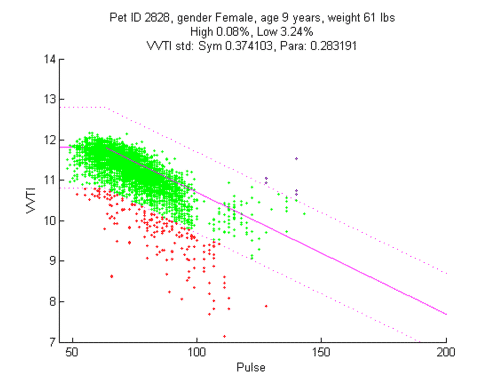Patient Condition and History
Pippa, a nine-year-old, 61lb spayed female Labrador Retriever has suffered from Hip Dysplasia from a young age.
Hip Dysplasia is a common disease affecting mostly large breed dogs, but also smaller breed dogs and cats. It involves a malformation of the hip joint that causes laxity and subsequent degeneration and inflammation. Dogs suffering from Hip Dysplasia may experience chronic pain and require treatment.
A PetPace collar was placed on Pippa to assess her overall condition and well-being in light of her Hip Dysplasia.
Monitoring Data
Statistical analysis of Pippa’s data, available through the PetPace Health Report, provided insights into Pippa’s condition. PetPace compared Pippa’s values to average values for dogs of similar breed, age, weight, and gender, and found:
• Pulse – Pippa’s overall pulse values (average 74; range 51-123) were slightly better than those typically seen in female Labrador retrievers of her age and weight (average 79; range 49-108).
• Respiration – Her respiratory values (average 17; range 10-26) were similar to the values of the reference group (average 20; range 9-29).
• Resting – Pippa spent 90.8% of the time resting, which is lower than the overall species average (81%) but similar to other Labradors of her age and weight (92%).
• Positions – While most dogs like Pippa spend approximately 13% of their rest time lying on the left side, Pippa laid only 8% of the time on that side. This finding may suggest discomfort associated with lying on the left side, such as pain from hip dysplasia.
• HRV – all Heart Rate Variability indices, which are a potential objective markers for pain, were normal (e.g. VVTI average 11.5)
All Pippa’s values, with the exception of HRV, showed little day-to-day variation. It is interesting to note that HRV on occasion decreased to lower levels, possibly indicating intermittent pain or discomfort.

*PIPPA’S VVTI VS. PULSE CHART SHOWING ABNORMALLY HIGH AMOUNT OF POINTS BELOW THE NORMAL RANGE (RED POINTS).
To further investigate the possibility of intermittent pain, Pippa’s caregivers employed an additional analytical tool to examine minute-to-minute HRV. To create this chart, an HRV index called VVTI (Vaso-Vagal Tonus Index) is plotted against the corresponding pulse data recorded at the same time. Preliminary data shows a statistical correlation between excessive numbers of plot points below the normal range (red dots) and various medical conditions. Pippa’s chart showed that 3.2%, a higher than normal percentage of data points (red points), fall below the normal range.
Discussion
While Pippa did not show overt signs of pain, the values recorded by the PetPace collar indicated mild and intermittent pain. Her vital signs were normal or even slightly better compared to other dogs of the same breed, age and weight. However, the position data and the HRV analysis revealed an underlying problem.
Pippa’s overall average HRV was normal, but a close look at detailed HRV data, revealed that she has ups and downs,” which can indicate intermittent pain episodes which are common for pets with inflammatory joint diseases. Various internal and external factors, such as weather, exercise, diet, and more may exacerbate the background inflammatory condition, bringing about periods of pain.
The positions data also hint at possible chronic intermittent pain. Pippa adopted a behavior pattern that includes decreased amount of time spent lying on the left side, which could be associated with increased pain or discomfort specifically on that side.
The HRV and positions data are not specific for pain secondary to hip dysplasia. They are statistical parameters indicating that a problem likely exists. However, Pippa’s owner Dr. Nitzan Kroter, a
veterinary surgeon from Enfield, UK, believes that no other medical conditions are present and therefore the data indicates chronic, intermittent pain from her hip dysplasia.
Detecting chronic pain, especially if it is intermittent in nature, is a challenge in veterinary medicine. Pets learn to compensate and do not readily show signs of pain. They may continue to eat and sleep well, appear happy and content and even be moderately active,” said Dr. Asaf Dagan, DVM, Diplomate ABVP (Canine and Feline practice), and PetPace’s Chief Veterinarian. The long term data analysis and comparisons provided by the PetPace collar can help reveal these common pain conditions, that owners may not be aware of,” he added.
Pippa is a happy dog despite her medical condition,” said Dr. Nitzan Kroter, a senior partner in Medi-Vet, UK, and Pippa’s owner. The collar’s data help me detect those intermittent pain episodes and treat them accordingly,” he continued.
Conclusions
Detecting chronic pain in animals is challenging because pets tend to hide their symptoms and compensate for their discomfort. Nonetheless, it is important to treat the pain for both humane and medical reasons. Pain has significant effect on the wellbeing of the pet and may also have negative influence on its health. Despite this, surveys repeatedly show that pain is under-diagnosed in the pet population.
The PetPace collar helps detect chronic pain by monitoring physiological and behavioral parameters associated with pain assessment. PetPace uses both real-time and long-term analytical tools to detect data values that deviate from the specific values typical for that pet. Such deviations can indicate acute exacerbations of an existing painful condition. Finally, comparisons to pets with similar attributes, such as breed, gender, age and weight, provide additional insights into the pet’s condition and wellbeing.
Hip Dysplasia, and similar joint diseases that are associated with chronic pain and inflammation, are very common in dogs and cats. Using the PetPace collar long-term on these pets can help caregivers detect chronic and intermittent pain, guiding treatment for pain relief and improving overall quality of life.

